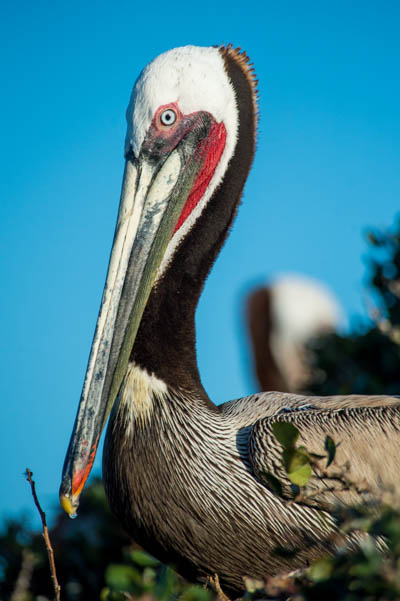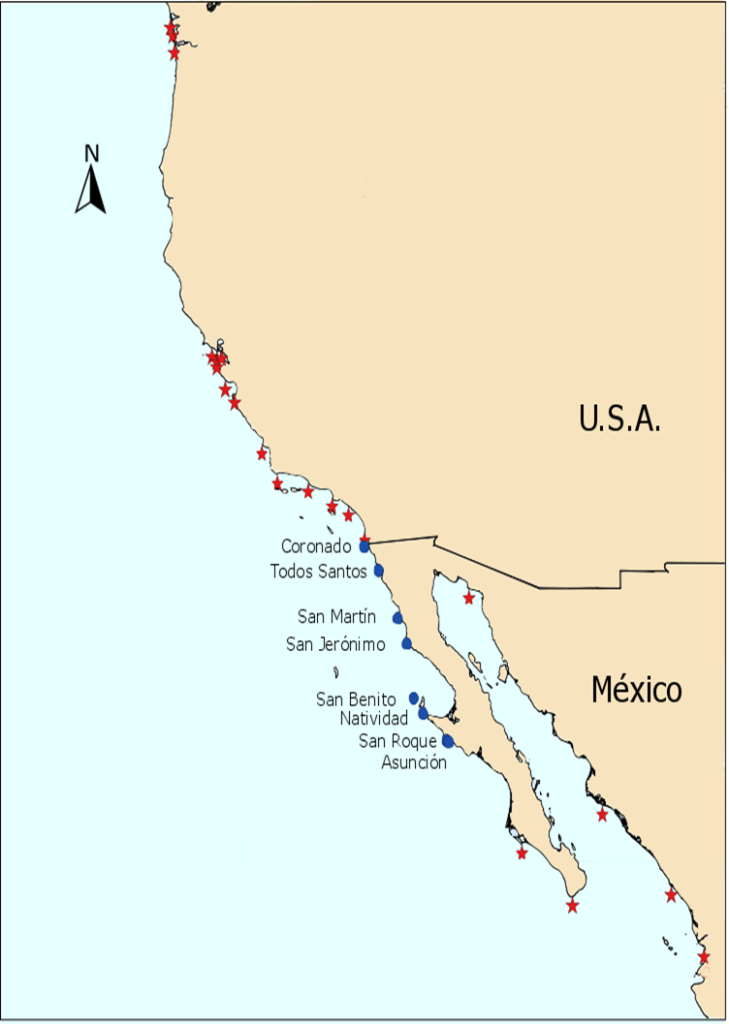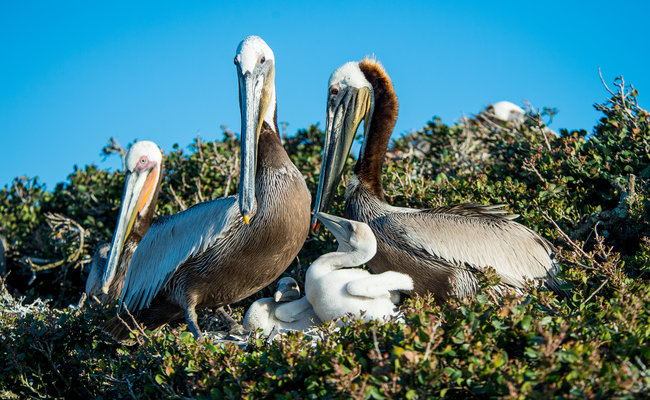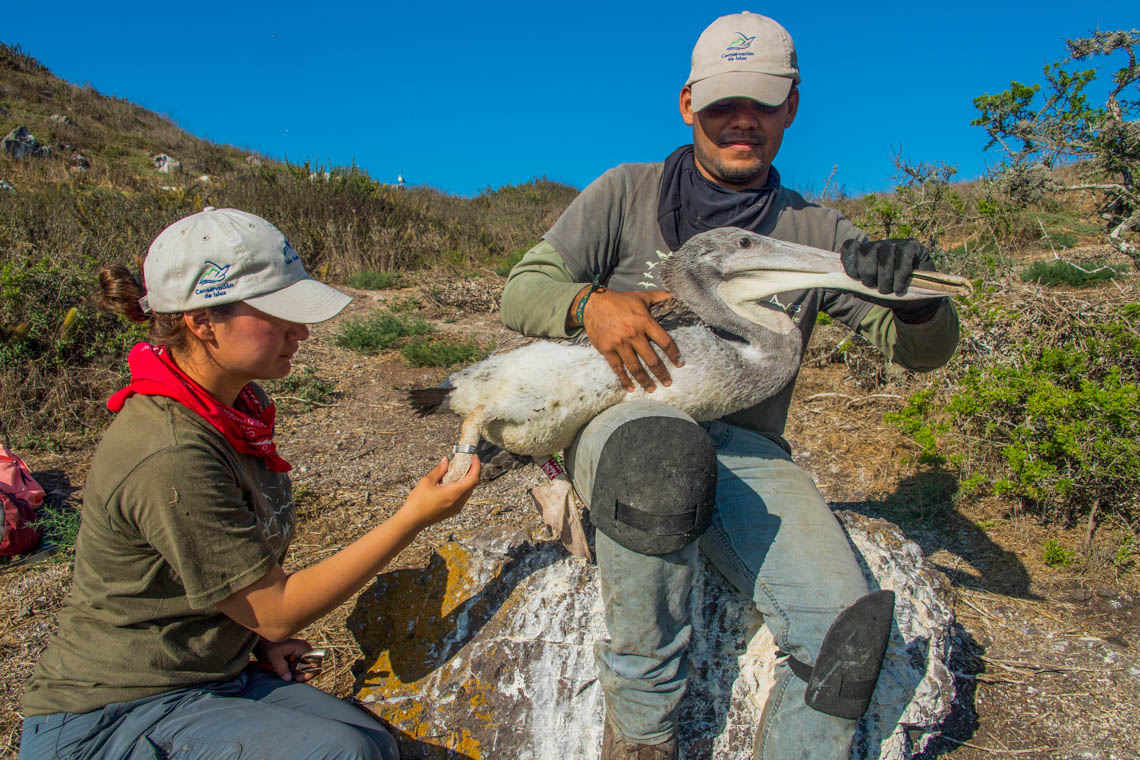By Esmeralda Bravo Hernández, Alejandro Aguilar Vargas, Alicia Aztorga Ornelas, Alejandra Fabila Blanco, Miguel Corrales Sauceda, María Félix Lizárraga and Yuliana Bedolla Guzmán of Grupo de Ecología y Conservación de Islas, A.C.
International coordination and collaboration is vital to achieve the conservation of wildlife species; seabirds are the prefect cause to promote combining efforts. The Brown Pelican (Pelecanus occidentalis) is a migratory species that shares breeding and feeding habitats between Mexico and the United States. Historically, both countries have developed different strategies for their conservation. In 1970, the United States banned the use of DDT after identifying its adverse effects in populations for this and other species, also classified the Brown Pelican as endangered, and in 1993 started a recovery plan that allowed a least concern classification by 2009. In Mexico, it is a threatened species in NOM-059-SEMARNAT-2010. The Brown Pelican serves as an indicator species. Long-term monitoring has taken place in the Gulf of California, where some of the biggest colonies are found.

In 2008 Grupo de Ecología y Conservación de Islas, A.C. (GECI), in collaboration with Cornell Lab of Ornithology, National Audubon Society and the Mexican Fund for the Conservation of Nature, started the Seabird Restoration Program on the Baja California Pacific Islands. The Brown Pelican is one of 22 target species in restoration and monitoring activities, currently nesting in Coronado, Todos Santos, San Martin, San Jeronimo, San Benito, Natividad, San Roque, and Asuncion islands. Activities include nesting census, monitoring of breeding success, diet identification by regurgitation, biological samples, and since 2015, fledgling banding.
Banding consists on placing a metal ring on the fledgling’s right leg with a unique number and contact information, and a red Darvic ring with white lettering on the right leg with alpha-numeric code for easy reading. Banding pelicans allows us to obtain information about dispersal of the populations, mortality and survival rates, and to help develop conservation and education programs.

Repeat sighting of banded individuals has generated a broad collaboration network between Mexico and the United States. In the last three years, 533 fledglings have been banded in the eight different Mexican islands. There have been 388 re-sightings matching 175 individuals. 74% of the re-sightings are from the San Francisco Bay and its surrounding areas in Marin, San Francisco, Alameda, San Mateo, Santa Cruz, and Monterey counties. The northernmost sighting was at Grays Harbor, Washington, 2,000 Km from the island where the individual was banded! These records have come from naturalists, researchers, and the United States Bird Band Laboratory. The banding program has also strengthened communication between Mexican colleagues. We have received sightings from the public, researchers, and through the National Commission for Natural Protected Areas (CONANP), and fishers from the Gulf of California, Baja California Pacific, Sinaloa, Sonora, and south to Nayarit. Likewise, GECI has witnessed the successful rehabilitation of a banded pelican released in 2010 by the International Bird Rescue’s Los Angeles Wildlife Center, which was able to successfully raise two chicks in San Jeronimo Island in 2017.

Environmental authorities in Mexico and the United States maintain agreements to protect this species from the 1972 amendment to the Migratory Bird and Game Mammal Treaty with Mexico to add the Brown Pelican, among other species. However, there is still great opportunity to formalize joint binational efforts to monitor populations for this migratory species given the different threats such as adverse oceanographic conditions and associated food availability, oil spills, and bycatch in pelagic fisheries. Currently, all colleagues participating in this species’ monitoring and conservation in the Pacific Ocean and the Gulf of California are working on creating a binational collaboration network to identify Brown Pelican conservation strategies. This group will come together for the first time during SJV’s Science Working Group meeting in Ensenada, Mexico in early June 2019. To learn more about how to participate in the meetings, please contact Jennie Duberstein.
If you see a Brown Pelican with a red band with white lettering, we appreciate you sharing the information with anillos@islas.org.mx or call +52 646 173 4943.

